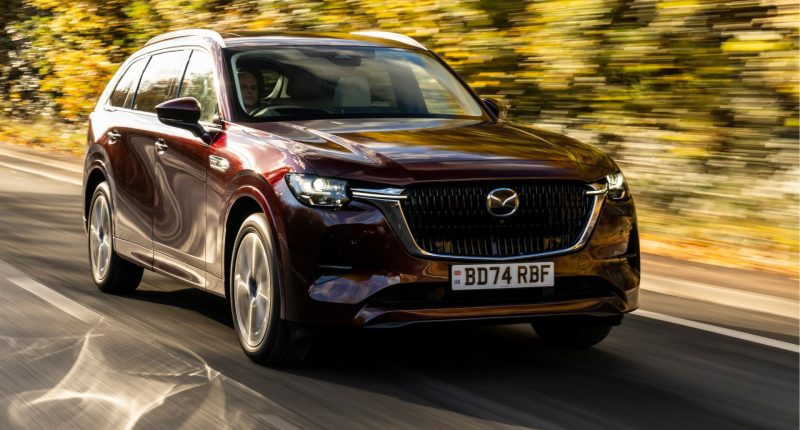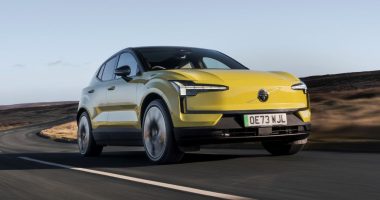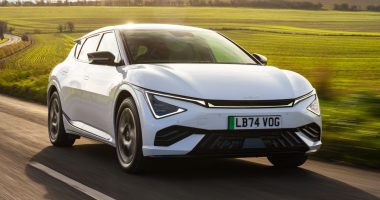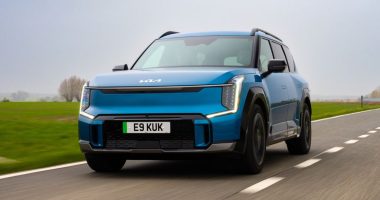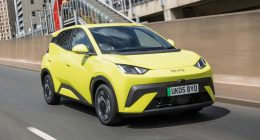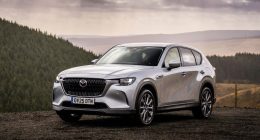You cannot have failed to notice that cars are getting bigger and, all the while, the size of parking bays and the width of our roads have remained fairly constant. For its part, Mazda appears to be adding to a growing (no pun intended) problem with its latest offering: the rather imposing seven-seat CX-80 SUV.
To cram in another row of chairs, Mazda has taken the smaller but still pretty chunky CX-60 and stretched its wheelbase to create this contender to the Hyundai Santa Fe, Kia’s Sorento, the third-generation Peugeot 5008, and recently face-lifted Kodiaq from Skoda. Of course, the CX-80 also aligns with Mazda’s quest to rub shoulders with costlier, more ‘premium’ marques, and by using the CX-60 as the base, it has developed it in record time.
However, there is a lot more going on here than engineers taking the hassle free way out and simply injecting 250mm of metal into the chassis, which, importantly, debuts a number of tweaks, many of which are in the process of being rolled out to the lithe, but harsh riding, CX-60. The changes lend themselves to a softly sprung ride but not at the complete expense of handling agility and communicative steering. We cannot fault it, yet if maximum ride comfort is a must for you when buying a seven-seater, you should start your search elsewhere.
Powertrains are capped at two and comprise a plug-in hybrid that uses a 2.5-litre, four-cylinder petrol assisted by an electric motor energised by a 17.8kWh battery. It delivers plenty of punch (323bhp) and a claimed electric-only range of 38-miles from the 173bhp e-motor. Our personal favourite is on test here: a 3.3-litre, straight six turbo diesel that has 251bhp and a knockout torque figure of 406 lb ft – enough to get you, your passengers and their gear from 0-62mph in 8.4 seconds. This strong, on-road performance is really helped by no noticeable gaps in power delivery compared to the petrol-electric set-up, and the trick all-wheel-drive system serves up endless grip under hard acceleration in the wet and the dry. Despite its mass, on the move, this is a car you can happily bowl along in. The cherry on the top is a realistic miles-per-gallon reading in the early 50s on long drives.
As for how the CX-80 looks, there is no getting away from how long it is, yet still, this is a pretty handsome car. What helps is the oversized grille, slim LED headlights and fuss-free bodywork. The optional (£900) ‘Soul Red Crystal’ metallic paint dazzles and looks spectacular in the Spring sunshine, although the standard 18-inch alloy are going to be lost due to the size of the arches not to mention the CX-80’s ride height, which is exactly 30mm more than the CX-60’s.
Buyers have a choice of five trims to mull over, starting with ‘Exclusive-Line’ and moving up to ‘Takumi’ and ‘Takumi Plus’ models, and finishing with ‘Homura’ and ‘Homura Plus’. Prices come in at just under £50,000 and rise to a smidge over £56,000, with Mazda charging a premium anywhere between £2,535 and £2,745 for the diesel motor over the PHEV.
All come well equipped, with music and media, air-conditioning, navigation and third-party apps such as Spotify all voice operated. Mazda’s easy-to-use tech is packaged into its Connect Multimedia System. It features a 12.3-inch dash-integrated central screen and a windscreen projected colour head up display that can be adjusted depending on your preferred seating position. Our test car came with the £1,400 ‘Comfort Pack’ (20-inch alloys, electric, heated and ventilated front seats, and heated rear seats) and the £1,750 ‘Convenience and Driver Assistance Pack’ (surround camera, adaptive headlights and adaptive cruise with lane centering, wireless phone charger and darkened rear glass).
Fit, finish and layout in the CX-80 is a ‘Ctrl C’ and ‘Ctrl V’ of the CX-60 and that also means a higher than usual ratio of physical buttons, knobs and switches – perfect for when you want to adjust the heating or ventilation settings as they are clearly laid out.
The real change is to be found in rows two and three – naturally. Regular CX-80s have a two-plus-three-plus-two configuration, with those chairs in the final row large enough to carry adults – a trick not all large SUVs pull off. However, it can also be ordered with six seats, should you wish. Go for this £750 alternative and the middle bench makes way for two Captain’s-style chairs, to create a limousine-like arrangement, with either a gangway leading to the rear seats, or a centre console sitting between these. In terms of overall boot space, this totals 285-litres if all the seats are occupied, and mushrooms to over 1,900-litres should you need to fold the rear and middle rows out of the way.
